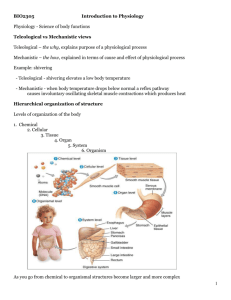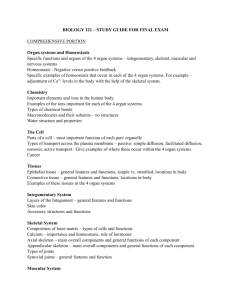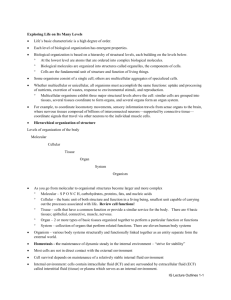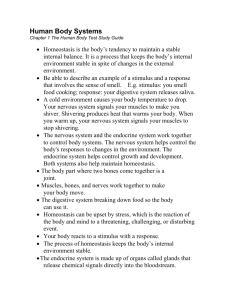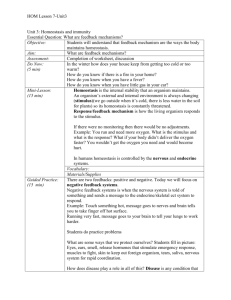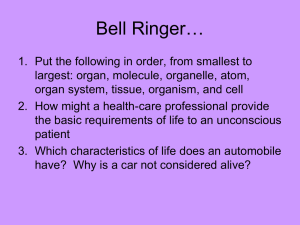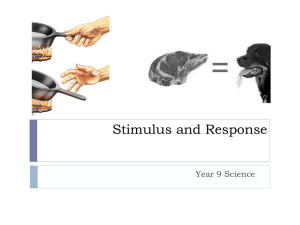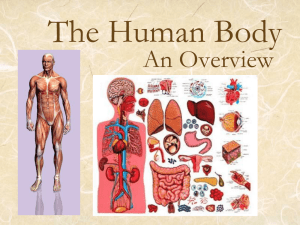ecture Notes - Introduction
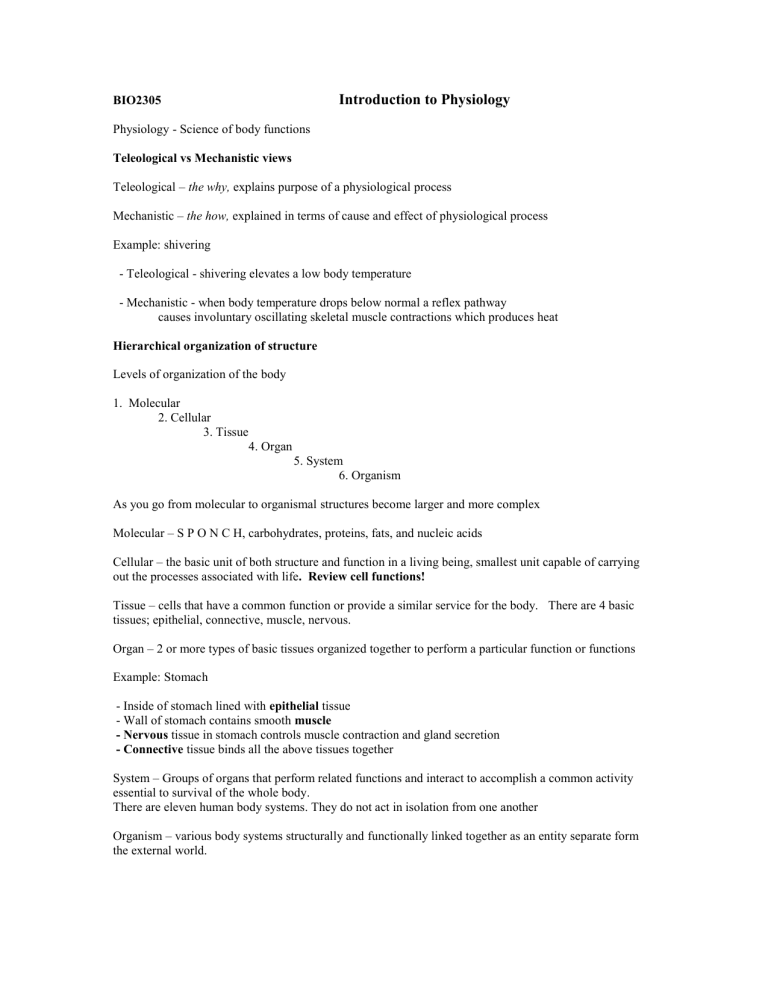
BIO2305
Physiology - Science of body functions
Introduction to Physiology
Teleological vs Mechanistic views
Teleological – the why, explains purpose of a physiological process
Mechanistic – the how, explained in terms of cause and effect of physiological process
Example: shivering
- Teleological - shivering elevates a low body temperature
- Mechanistic - when body temperature drops below normal a reflex pathway causes involuntary oscillating skeletal muscle contractions which produces heat
Hierarchical organization of structure
Levels of organization of the body
1. Molecular
2. Cellular
3. Tissue
4. Organ
5. System
6. Organism
As you go from molecular to organismal structures become larger and more complex
Molecular – S P O N C H, carbohydrates, proteins, fats, and nucleic acids
Cellular – the basic unit of both structure and function in a living being, smallest unit capable of carrying out the processes associated with life . Review cell functions!
Tissue – cells that have a common function or provide a similar service for the body. There are 4 basic tissues; epithelial, connective, muscle, nervous.
Organ – 2 or more types of basic tissues organized together to perform a particular function or functions
Example: Stomach
- Inside of stomach lined with epithelial tissue
- Wall of stomach contains smooth muscle
- Nervous tissue in stomach controls muscle contraction and gland secretion
- Connective tissue binds all the above tissues together
System – Groups of organs that perform related functions and interact to accomplish a common activity essential to survival of the whole body.
There are eleven human body systems. They do not act in isolation from one another
Organism – various body systems structurally and functionally linked together as an entity separate form the external world.
Basic Cell Functions
- Obtain nutrients and oxygen from surrounding environment
- Perform chemical reactions that provide energy for the cell
- Eliminate carbon dioxide and other wastes to surrounding environment
- Synthesize needed cellular components
- Reproduction (exception nerve cells and muscle cells lose their ability to reproduce during their early development)
- Sensing and responding to changes in surrounding environment
- Control exchange of materials between cell and its surrounding environment
Homeotasis - Defined as maintenance of a relatively stable internal environment or the maintenance of a steady state in the dynamic internal environment – “strive for stability”
Does not mean that composition, temperature, and other characteristics are absolutely unchanging
Homeostasis is essential for survival and function of all cells
Each cell contributes to maintenance of a relatively stable internal environment
- Most cells are not in direct contact with the external environment
- Cell survival depends on maintenance of a relatively stable internal fluid environment
Body cells are in contained in watery internal environment through which life-sustaining exchanges are made
- Extracellular fluid (ECF) - Fluid environment in which the cells live (fluid outside the cells)
- Two components: Plasma and Interstitial fluid
- Intracellular fluid (ICF) - Fluid contained within all body cells
Homeostasis involves dynamic mechanisms that detect and respond to deviations in physiological variables from their “set point” values by initiating effector responses that restore the variables to the optimal physiological range.
Two systems involved in maintaining homeostasis
Nervous system - Controls and coordinates bodily activities that require rapid responses
Detects and initiates reactions to changes in external environment
Endocrine system - Secreting glands of endocrine regulate activities that require duration rather than speed
Controls concentration of nutrients and, by adjusting kidney function, controls internal environment’s volume and electrolyte composition
Factors homeostatically regulated include
> [C] of nutrients, O2
> [C] of CO2, wastes, byproducts
> pH
> [C] of water, electrolytes
> Temperature
> Volume/Pressure
Homeostasis is essential for each cell’s survival and each cell contributes to a body system function striving to maintain homeostasis
Homeostasis is continually being disrupted by
- External stimuli; heat, cold, lack of oxygen, pathogens, toxins
- Internal stimuli; body temperature, blood pressure, concentration of water, glucose, salts, oxygen, etc.
- Physical and psychological distresses
Disruptions can be mild to severe
If homeostasis is not maintained, death may result
Homeostatic control systems
Network of body components working together to maintain a given factor in the internal environment directed at an optimal set level
- Intrinsic control -involves detecting deviations and making corrections within an organ, often called autoregulation, benefits the organ, not the organism
- Extrinsic control – responses of an organ that are triggered by factors external to the organ or systems.
Can over-ride intrinsic regulation, benefits the organism, not necessarily individual organs
To regulate homeostasis the body uses an electrical system (nervous) and a chemical system (endocrine - hormones). The nervous system (milliseconds) is generally faster than the endocrine system (seconds to hours). Both systems primarily act automatically, but there is some voluntary control over the nervous system
In order to maintain homeostasis, control system must be able to detect deviations from normal in the internal environment that need to be held within narrow limits and integrate this information with other relevant information, then make appropriate adjustments in order to restore factor to its desired value
Feedforward - Term used for responses made in anticipation of a change
Feedback - Refers to responses made after change has been detected
Feedback mechanisms - feedback mechanisms are the general mechanism of nervous or hormonal regulation. Occurs when the response to a stimulus has an effect of some kind on the original stimulus.
Negative feedback response opposite of original deviation returns variable to set point stable, long-term control, used for conditions that need frequent adjustment. It is most common in biological systems. Intrinsic and extrinsic control systems generally operate on the principle of negative feedback.
Examples:
1. Blood glucose concentrations rise after a sugary meal (the stimulus), the hormone insulin is released and it speeds up the transport of glucose out of the blood and into selected tissues (the response), so blood glucose concentrations decrease (thus decreasing the original stimulus).
2. Exercise creates metabolic heat which raises the body temperature (the stimulus), cooling mechanisms such as vasodilation (flushed skin) and sweating begin (the response), body temperature falls (thus decreasing the original stimulus).
- Positive feedback Original stimulus intensified or reinforces original deviation causing rapid and temporary change in a variable - seen during normal childbirth:
> Stretch receptors in walls of uterus send signals to the brain > brain induces release of hormone
(oxytocin) into bloodstream > uterine smooth muscle contracts more forcefully > More stretch, more hormone, more contraction etc. Cycle ends with birth of the baby & decrease in stretch
It is less common as most changes to steady state pose a threat, and to enhance them would be deleterious.
Feedback Loops
Regardless of whether the feedback is positive or negative, feedback mechanisms have certain essential components. You should be able to identify each of these and explain their role.
1.
Stimulus: A change from optimum or resting conditions
2.
Sensor / Receptor: Cells or tissue which detects the deviation due to the stimulus
3.
Relay: Transmission of the message, via nerves or hormones or both
4.
Integrator / Control center - compares input from sensors with set point and coordinates the effectors
5.
Effector: Cells, tissue or organ (usually a gland or muscles), which cause the response to happen.
6.
Response: Corrective action, at cell, tissue or whole organism level that drives the variable in the opposite direction of the initial change (back to optimum set point)
7.
Feedback: The consequence of the response on the stimulus. May be positive or negative used by the system to determine further action.
If the set point has not been reached, effectors continue to produce output, If the set point has been reached, then the effectors stop producing output
EXAMPLE:
In addition to feedback mechanisms, the body less frequently employs feedfoward mechanisms which bring about a response in anticipation of a change in a regulated variable
Pathophysiological states develop when body systems fail to maintain an optimal internal environment.
Serious homeostatic disruption leads to death.

